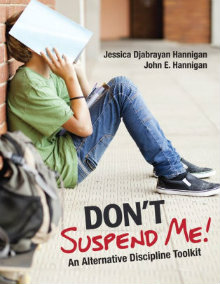A Principal’s Toolkit for Suspension Alternatives
Don’t Suspend Me! An Alternative Discipline Toolkit
By Jessica Djabrayan Hannigan and John E. Hannigan
(Corwin, 2017 – Learn more)
Reviewed by Mary Langer Thompson


I dealt with discipline issues daily, and I did try to think outside the box, writing and typing individual contracts with students having to check in with me weekly, conferring with teachers, often calling social services to get involved, and more. Several times a month principals were called to be on a panel that recommended expulsion or a different setting. This was so unlike my previous years of co-administrating when the office would be free of discipline referrals for weeks and then infractions were minor.
The complexity of suspensions
My school board didn’t want exceptions or alternatives for suspension for violence involving a weapon, drugs or weapons brought to school, including pocket knives, or starting fires: all grounds for expulsion, not just suspension. This book suggests that even these offenses have alternatives. I’m not totally convinced.
The authors argue that administrators suspend to save time. Then they say how long a typical suspension takes: 45-60 minutes. But a suspension can take days. Students have to be given due process, and during that time, which can be lengthy, the caring administrator listens to explanations of behavior and considers what’s going on in the classroom (perhaps a class change is in order?), empathy development, social skill abilities, health issues with needs for possible IEP’s, counseling, or other interventions that might be necessary before making a judgment whether or not to suspend or use one or more of the alternatives suggested.
Also suspensions require a meeting with parents and often in that meeting the student’s acceptance of responsibility is turned around as the parent blames someone else (more investigation required), often even the principal. Years of a dysfunctional family dynamic are often behind a decision to suspend because of extreme anger directed at the school or fellow students, and this is the time that the principal can give information to parents to get needed counseling.
I believe when most principals decide to suspend outside of school, it is justifiable. Could we do more restorative follow-up upon a student’s return? Yes, and this is where this book and the suggested behavioral team would be most useful.
Bringing PBIS to schools
The ideal use of the book would be to have the authors or those trained in the model (Positive Behavior Interventions and Supports Champion Model System – PBIS – for which the ed consultant, Dr. Djabrayan Hannigan, and the co-author principal, Dr. John E. Hannigan, have been recognized) come to a district and train administrators and teachers, with their buy-in.
The value of positive school-wide programs
School-wide programs like a student council and a basketball team with a beloved coach dropped my suspensions tremendously. All I had to do was give a look to students about to fight or commit an infraction, and they knew they would be kicked off the council or team they loved and that gave them status and self esteem. I’m afraid the authors will say this threat is the same as suspension since it is punitive, but I think I was tapping into students’ goals for themselves and these were groups they didn’t want to be excluded from, so behavior changed.
So I would have liked for the book to include positive school-wide programs, maybe a grief group, a kids-of-divorce group, or a foster kids group as preventive suggestions. Some of the alternatives were too private or individual (interviewing a custodian for school damage).
In other words, the student might change, but the culture might not, and different students would be acting inappropriately. At one point, I also determined that students weren’t getting values “input,” so searched and found the program “Project Wisdom,” that allowed me to give a short message on the all-call each morning with quotes and examples from people like MLK. Each message ended with “Make it a good day, or not. It’s your choice.” Students would parrot that back to me on the playground or in my office and say, “I know. I made a bad choice.”
Fitting the alternatives to the student population
Because in low-income area schools students struggle more to read and write in both their native language and English, I was disappointed to see that the book’s alternatives were heavily based on student reading and writing skills (writing apologies, researching bullying laws and “tolerance,” developing a “Project,” reading a book – bibliographies would have been helpful) with some tough vocabulary that an adult will have to explain and interpret. What about a run around the track or something physical? Students sit for too long each day.
There is a suggestion for a “safe zone” on campus, and I believe the entire campus is supposed to be safe (we even had a ‘safe routes to school’ map). I often suspended because of threats to even teachers’ safety. That doesn’t mean some of the measures suggested shouldn’t be a follow-up to suspension for “restorative” results. Also, I agree with the authors that if a student is truant, sending them home will do no good, and would use the suggestions here.
While reading, I also wished that more teachers would teach some of the social skills in every class that are being suggested as alternatives to suspension, such as what an apology should include. In other words, this book might be better as a social skills curriculum in the hands of teachers. Some schools have a homeroom where these skills are taught, if only for ten minutes a day.
Who can benefit by adapting this toolkit
The best use of this book (for those who do not have the full PBIS program at work in their districts and schools) is for lone principals (with no co-administrator) to use its templates and suggestions for minor infractions. It could be used with a discipline team (from the book’s suggestion – I would form one with willing teachers) and by teachers as a social skills curriculum.
The authors got me thinking about further alternatives to suspension. This book can begin a much-needed school and district discussion.
Dr. Mary Langer Thompson’s articles, short stories, and poetry appear in various journals and anthologies. She is a retired school principal, who now writes and teaches writing workshops in schools, in prisons, and in her community. Her anti-bullying children’s book, How the Blue-Tongued Skink Got His Blue Tongue, recently received the Indie Excellence Finalist Award and is available in both English and Spanish.






























